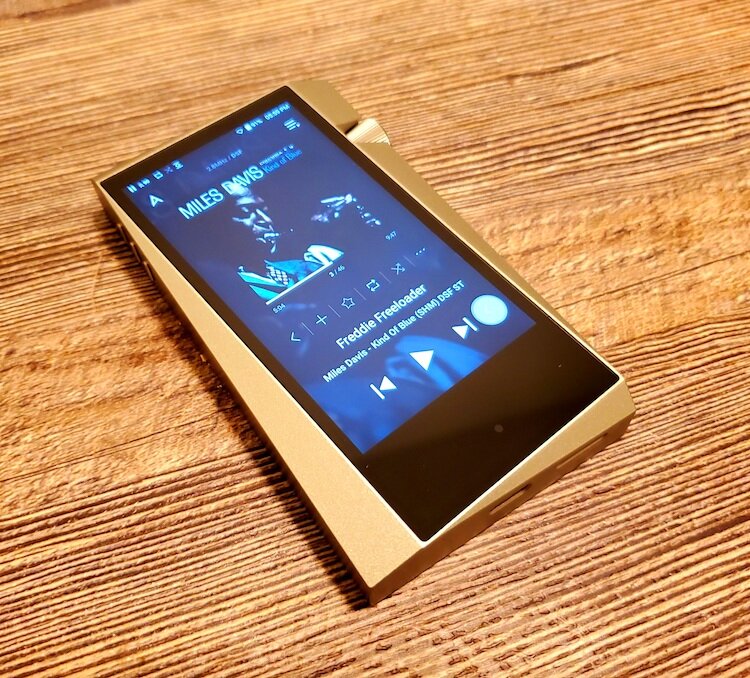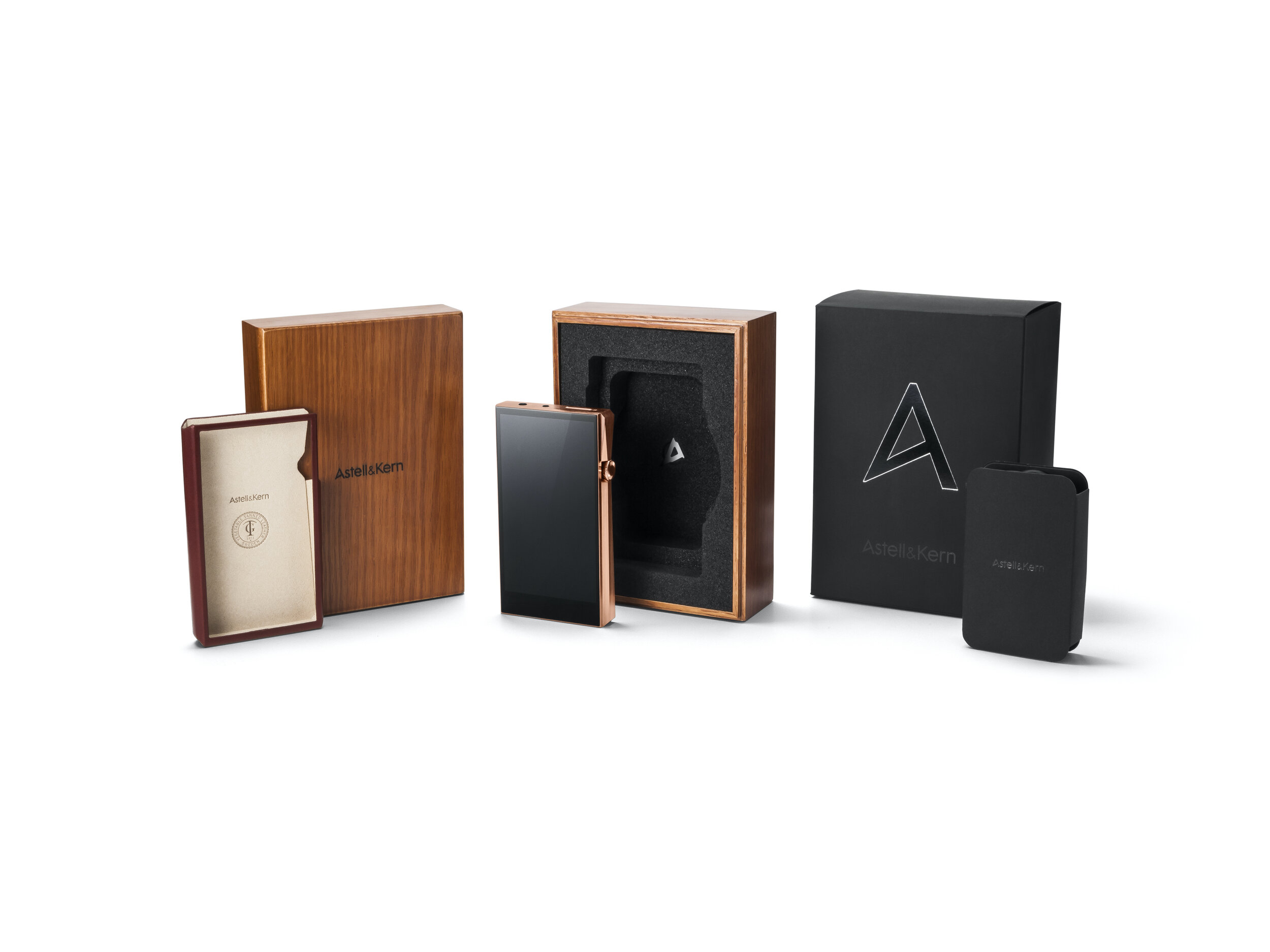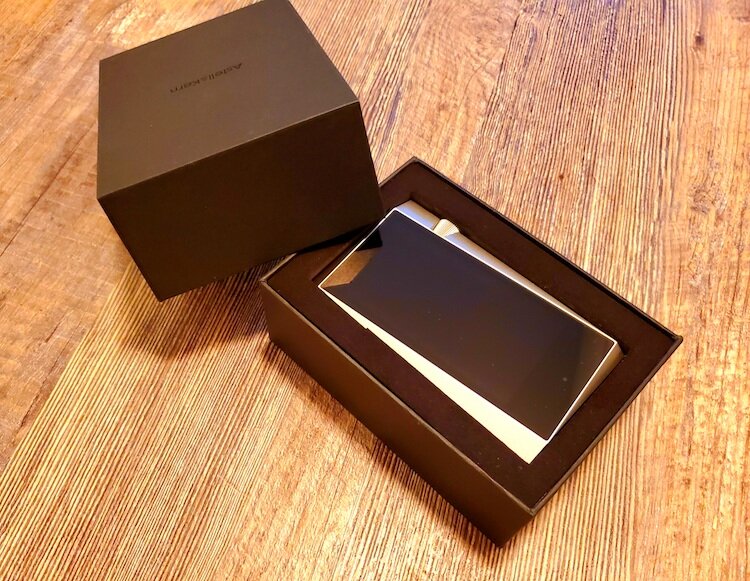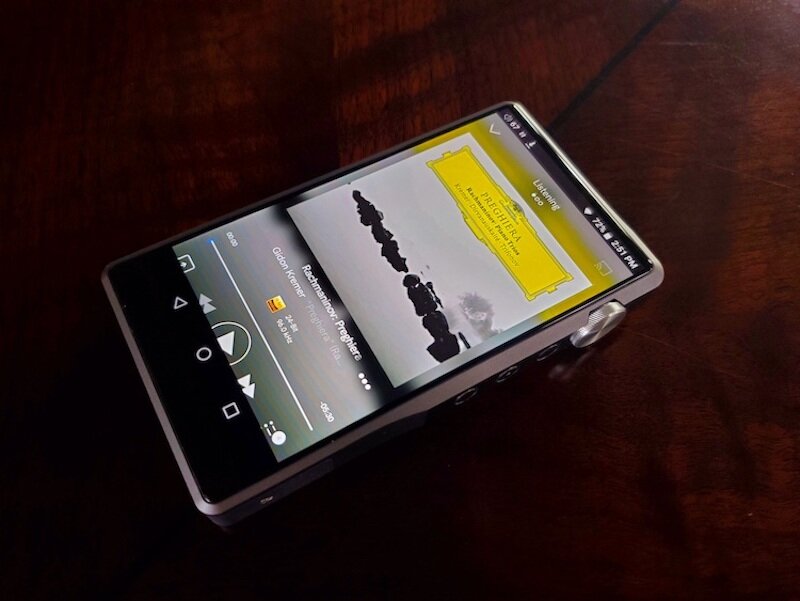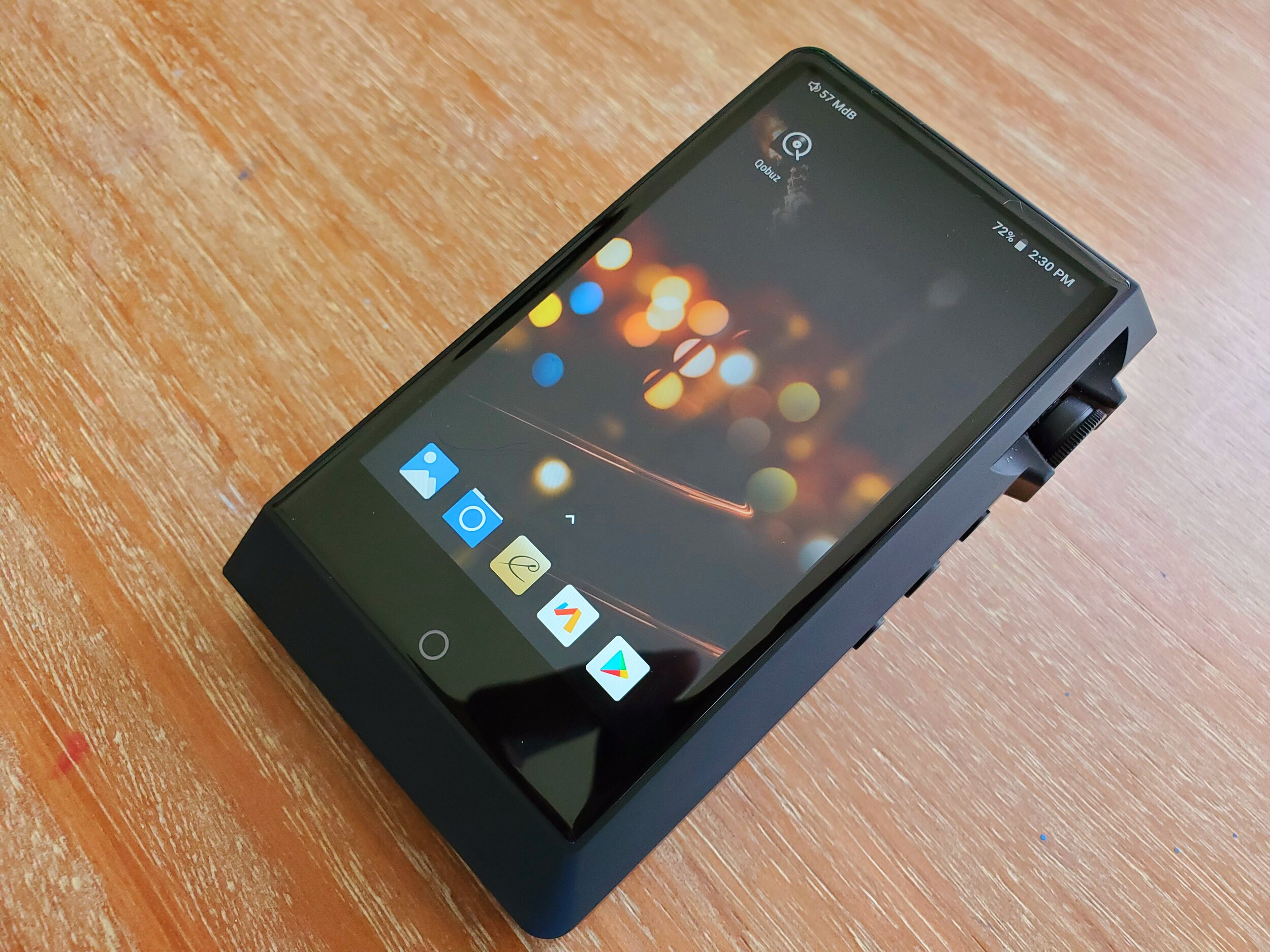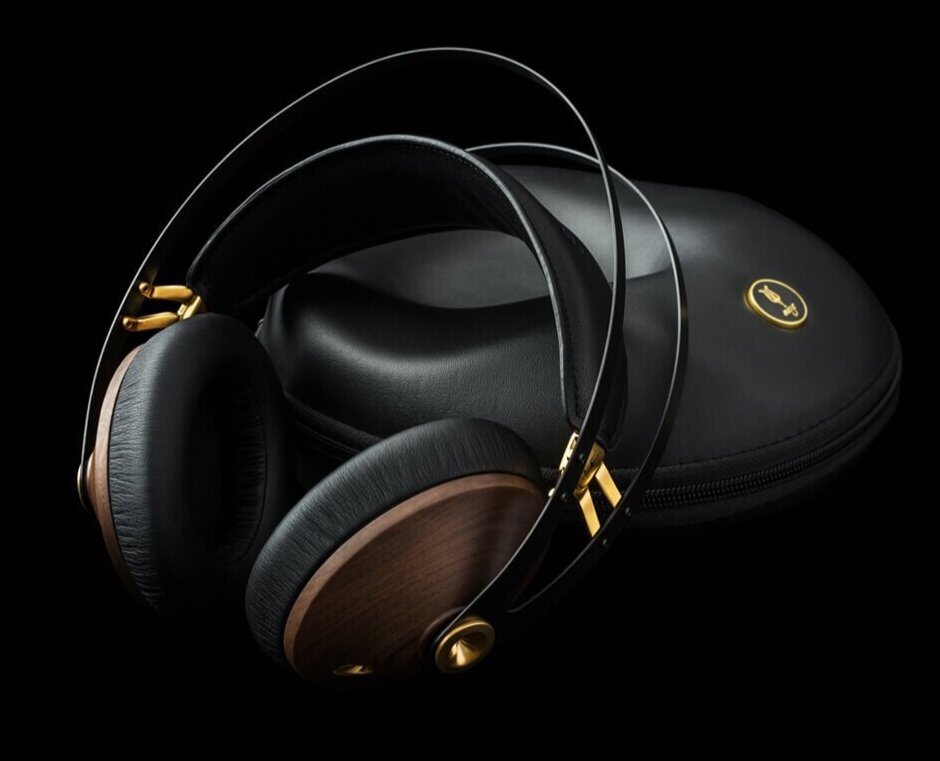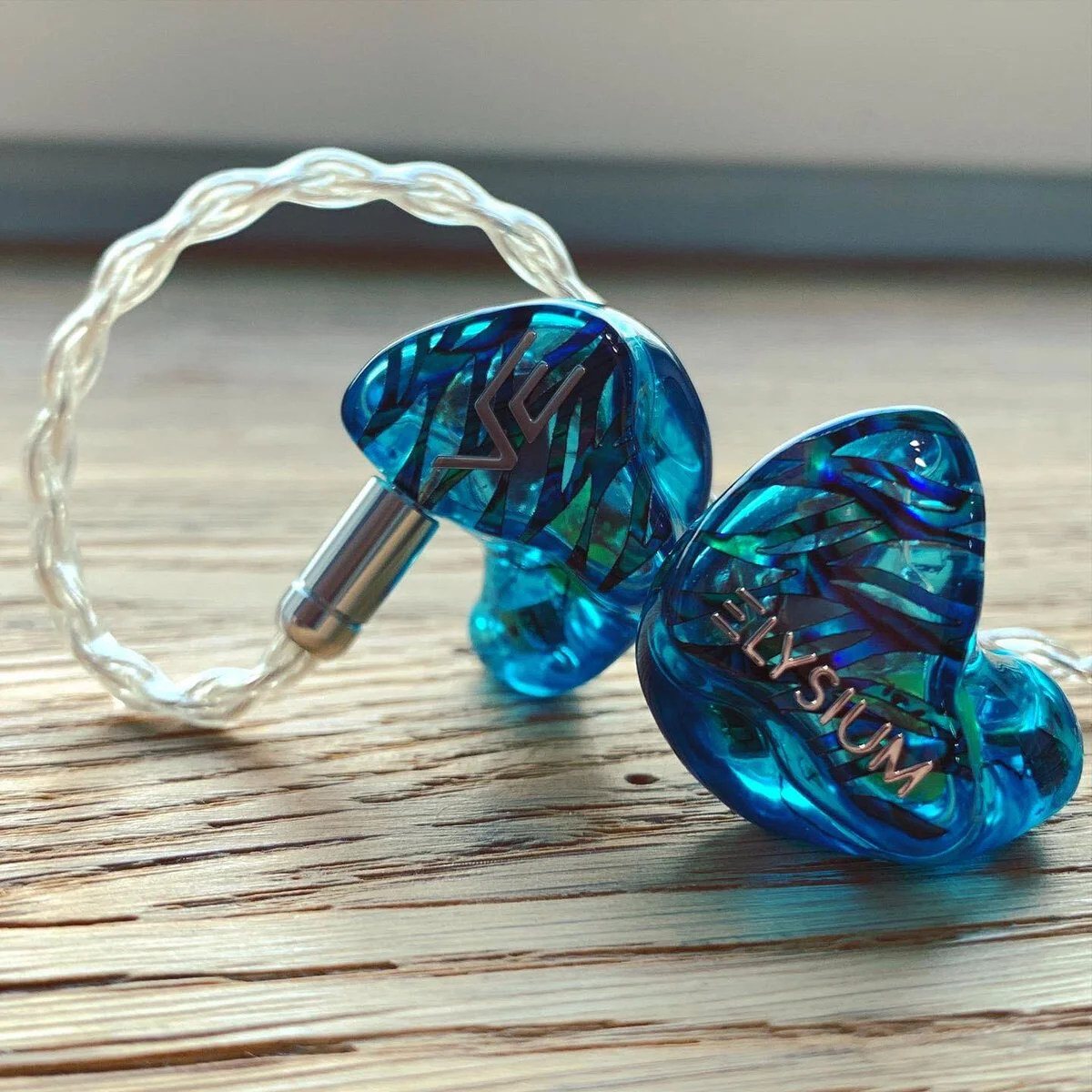ASTELL&KERN SR25 REVIEW
Incredible Transparency Weds Wondrous Musicality!
In the late 1990’s, prior to Apple’s creation of the iPod, the company, IRIVER, had been manufacturing consumer electronic products and some of the first portable music players in the world. Music players that were capable of both lossy and CD-quality music playback. For the next twenty plus years IRIVER would continue to produce portable players, while engaging a parallel engineer goal—“What if we could construct a portable device that was able to render music exactly as it was recorded in the studio?”
Several years later in 2008 IRIVER’s engineers noticed that the technological and economic pieces necessary for such a player—increasing availability of mobile chipsets, larger storage options, and the advent of HDtracks, the first online seller of downloadable, high-resolution files, was finally at hand. And so began IRIVER’s Project Teardrop, which IRIVER defined as:
“A reference to the great emotional response music brings to the listener. The goal being to invoke that emotional response every time someone used one of the new hi-res players.”
Four years later, in 2012, Neil Young announced the Pono Portable Music Player. Several weeks later IRIVER announced its first portable, high-resolution music player complete with a touchscreen interface, an analog volume wheel (that would become iconic for the brand) and physical navigation buttons (play/pause, forward, backward). It was the AK100 and its brand name was Astell&Kern.
IRIVER now Dreamus would introduce in May 2013 the world’s first high-resolution, portable player with dual DACs—the AK120. And at CES 2014 the company launched its first Android-based, Wi-Fi enabled player—Astell&Kern AK240—with the music streaming service, Tidal, as standard to the player. And in June 2017 Astell&Kern debuted their flagship—the SP1000 (pictured below). The Astell&Kern brand has now become iconic and known the world over.
As one of the very first developers of the Digital Audio Player (DAP) Dreamus—Astell&Kern—was ever-present in conversations, across websites, and certainly in the audiophile and headphone communities. The Astell&Kern brand had been known to me for quite sometime, though I had not heard any of its products. I was always curious.
In truth, at the time of Astell&Kern’s rise, I was firmly entrenched in two channel audio—amp/integrated, CD player/DAC, and speakers—as I believed there was no better source for communicating music’s harmonic gestalt. I had certainly owned headphones over that time period, but in my recollection, they served as a secondary source of musical enjoyment, necessary for quiet, at-home moments. How times have changed and how technology has changed the times. My “awakening” would finally come when planar magnetic headphones made a most profound 21st century debut.
Suffice to say, that headphones and the associated headgear have me firmly in camp, having made quantum leaps in their ability to “bring the music,” as never before. And, as a result of the rapid improvement in both headphone technology and Digital Audio Players (DAPs), I am thoroughly enjoying headfi. This, of course, leads into my current review of the Astell&Kern SR25 ($699), which represents “first contact,” for me, of one of the most iconic and notable Digital Audio Player (DAP) brands in the world.
REFRAIN: Unlike most reviews, this review will be non-sequential, as it will start with how the equipment actually sounds and not the process of physically “undressing” it and/or laying out its various accoutrement, specifications, etc. Think of this review then, as a non-linear movie—Memento, Kill Bill, Pulp Fiction, Terminator, The Eternal Sunshine of the Spotless Mind, etc—that, likewise, starts at the end and winds its way to the beginning.
The Sound
The Astell&Kern SR25 came fully burned-in, which is always greatly appreciated and saves, depending on the burn-in schema, from a few days up to a month or more. Burn-in, for those mildly aware/skeptical, allows for the technology to come to full saturation via the various internal parts “handshaking” enough for fluid, synergistic relationships, and for the music to rise unimpeded and naturally from the mix of architected, electronic circuitry. New shoes, a new car, a baseball glove, a new path through the woods, all take time to break-in. Not having to wait, I got immediately to the review.
Whether Jazz or Hip-Hop or Rock, Classical or Techno, blues or R&B the Astell&Kern SR25 proved to be an efficient and musical workhorse. The SR25 delivered transparency—detail, staging cues, microdynamics—from basement to penthouse, that revealed detail far in excess of its like-priced rivals. The engagement and release of piano pedals, the turning of pages among orchestra members, the microdynamics of words being formed and leaving a singer’s mouth (often missed by its like-priced rivals) was revelatory.
And while there are a few ways to listen to music with the Astell&Kern SR25—WiFi, Bluetooth, USB (as DAC only), and internally stored media downloaded from purchases or from the catalogs—Tidal, Qobuz, Amazon Music, etc.—the downloaded music provided the highest fidelity and the most musically engaging and detailed listen.
The Astell&Kern SR25’s volumetric cube—its soundstage—width, depth, height—is broad and deep, its background black-quiet, and its staging cues—layering, positioning, separation, microdynamics—truly impressive. Though when the SR25’s 2.5mm balanced output was engaged, literally, everything—power, detail, dynamics, soundstage, quiet—improved! The 3.5mm singled-ended (SE) output did, however, retain a wee bit more warmth.
The Astell&Kern SR25 for the purposes of this review was paired with the the MEZE 99 Classics, the VISION EARS EVE2020, and the VISION EARS ELYSIUM. The music was sourced from the SR25’s onboard folder from downloaded Qobuz and Tidal files.
Bass
I cue Massive Attack’s Angel (Mezzanine, Virgin) for an analysis of the SR25’s bass capabilities. I initially start with the 3.5mm SE headphone out engaged. The bass is tight, dimensional, deep. There is great transparency, very good dynamics, and a richness of tone/timbre. In 2.5mm balanced out, everything simply grows up, with the exception of the richness, which diminishes, slightly. Bass via the 2.5mm is more taunt, deeper, detailed, and aimed directly at one’s chest. The soundstage has increased and the background is quieter still. The 3.5mm is very good, the 2.5mm balanced out, however, is simply quieter and more transparent.
Midrange
Kandace Springs’ I Can’t Make You Love Me (Kandace Springs, Blue Note) plays and the Astell&Kern SR25 captures my attention. Kandace’s voice is clear, laden with emotion, natural. Natural and organic and transparent are words that are peppered throughout my notes for the SR25 and for good reason. Gentle Rain follows and more of the same transparent, highly-engaging musicality. The SR25 allied to the VISION EARS EVE2020 pulls you easily from working to enjoying. I just listen. Isn’t that what music is all about? In Solitude, not originally intended as a review track, like Gentle Rain, a saxophone enters with bite and splat and body as it tangoes with Ms Spring’s voice, which soars, sustains, undulates, beautifully. The clarity, the richness, the emotion are outstanding.
Treble+
Sara Sant’Ambrogio’s cello and the Royal Philharmonic Orchestra serve as the litmus tests for the SR25’s treble performance, via Cello Concerto: II. Maestoso (Elgar, Piazzolla, Wolosoff, Sebastian Records). The movement begins with the full orchestra engaged. Sara’s cello soon enters and makes it slow, passionate, ascent. The soundstage is extended and black-quiet. Tone/timbre, texture are natural, highs are extended, detailed, never harsh. Transients and microdynamic cues are laid bare by the SR25’s transparency and speed. The rendering is sublime. Alternatively, how well are brushes over Hi-hats and cymbals resolved? Patricia Barber’s Invitation (Nightclub, Premonition Records) replete with brushes, Hi-hats, cymbals has become a test track for these very things. And on this song they are resolved beautifully—no “schhhschcccchh” or food-sizzling-on-the-grill cymbals—just music.
The Wrappings and Accessories
The Astell&Kern SR25 comes in a small, nearly form-fitting, silver, die-cut box with the company name, logo, and product designation debossed. The die-cut edge of the outer box exposes a sliver of the black, inner box at its front right surface. It is an understated design, that is clean, practical, and efficient.
The inner containing box is matte black with the Astell&Kern logo screen printed in a gloss black on its top surface. The design is minimalist and clean. Opening the inner box reveals the moon-silver SR25 comfortably settled within a foam berth, atop a die-cut, cardboard cutout, that holds instructions, warranty card, cables.
The overall design of the Astell&Kern SR25’s containing box is clean, minimalist, efficient. A definite nod in the direction of a reduced materials/carbon footprint and beautiful, understated, graphic design.
Design—Look and Feel and Fit
The Astell&Kern SR25 Digital Audio Player (DAP) embraces a bold and quite beautiful design, that utilizes art, industrial design, and architectural cues in what might be viewed as an oblique, metal sculpture. And given its angled facade and the moon-silver metal that surrounds it, elegant and avant-garde are very appropriate descriptors. Additionally, Astell&Kern SR25’s diminutive size makes it a compelling accomplice for pocketed, On-The-Go (OTG) listening (on land, air, or sea with 21 hours of playback!).
Functionality/Features
The Astell&Kern SR25 contains a Quad-Core CPU as aligned to dual Cirrus Logic CS43198 DACs, which provides native playback support of DSD256 and 32bit/384kHz audio. The SR25 has built-in Wi-Fi (2.4 GHz support), has adopted the Bluetooth LDAC codec for improved wireless sound, and provides for twenty-one (21) hours of continuous playback time. The SR25 also features an MQA codec which allows for the fully authenticated unpacking of Tidal Master Quality files. The question, however, of why no 5.0 GHz Wi-Fi support does come up.
The SR25 sports a 3.6”, 720 x 1280 touch-screen display on its front face. It features a 3.5mm single-ended headphone output, a 2.5mm balanced headphone output, an oblong On/Off button, and a volume knob on its top face. Three oblong control buttons are available on the SR25's left face (Skip Backward, Play/Pause, Skip Forward). And a USB-C charging/data port and a microSD slot capable of expanding the internal memory to 1 terabyte are on the SR25’s bottom face.
The Astell&Kern SR25 uses the Android 9.0 operating system and the Open APP Service, which translates to a wealth of downloadable apps, with Tidal, Qobuz, Amazon Music native to the SR25. The Astell&Kern’s “A” logo serves as the “Home” button, in the selfsame manner as on its website. Interaction is very intuitive and easily mastered.
A FEATURES list of the ASTELL & KERN SR25:
Quad-Core CPU
Cirrus Logic CS43198 Dual DAC
32bit/384kHz Bit-to-Bit Playback
Native DSD256 Playback
3.6” 720x1280 Touch Display
Aluminum Body
21 Hours of continuous playback.
3D Glass-Backed Plate
USB—C for charging and data transfer
Fully authenticated MQA
The Specifications
Model: SR25
Body Color: Moon Silver, Onyx Black, Carmen Red (US, Japan and Korea)
Body Material: Aluminum
Display: 3.6inch WVGA (720 x 1,280) TFT LCD
Supported Audio Formats: WAV, FLAC, WMA, MP3, OGG, APE, AAC, ALAC, AIFF, DFF, DSF, MQA
MQA playback: Services(Tidal Masters), Local files, External USB, MQA-CD(ripped)
Sample rate: PCM : 8kHz ~ 384kHz (8/16/24/32bits per Sample)
DSD Native: DSD64(1bit 2.8MHz), Stereo
DSD128(1bit 5.6MHz), Stereo / DSD256(1bit 11.2MHz), Stereo
Output Level: Unbalanced 2.0Vrms / Balanced 4.0Vrms (Condition No Load)
DAC: Cirrus Logic CS43198 x2 (Dual DAC)
CPU: Quad-Core
Decoding: Support up to 32bit / 384kHz Bit-to-Bit Playback
Input: USB Type-C input (for PC & MAC)
Outputs: Unbalanced Out (3.5mm) / Balanced Out (2.5mm, only 4-pole supported)
Wi-Fi: 802.11 b/g/n (2.4GHz)
Bluetooth: V4.2 (A2DP, AVRCP, aptXTM HD, LDAC)
Dimensions: 2.5 ”(63.5 mm) [W] x 4.26 ”(108.3 mm) [H] x 0.63 ”(16.1 mm) [D]
Weight: about 6.27 oz (about 178 g)
Feature Enhancements Firmware upgrades supported (OTA)
For additional details and specifications please check HERE.
Comparisons
The various DAPs were partnered to the VISION EARS EVE2020, the EMPIRE EARS ODIN, and the VISION EARS ELYSIUM IEMs, in order to get a complete sounding of their voices across various design implementations.
Four well known tracks were used for the review:
Kandace Springs’ I Can’t Make You Love Me (Kandace Springs, Blue Note)
Olafur Arnalds’ Árbakkinn (Island Songs, Mercury (Universal France))
Massive Attack’s Angel (MEZZANINE, Virgin) and
Eiji Oue’s The Firebird Suite (1919 version): VII Finale (Stravinsky, Reference Recordings)
iBasso DX220 AMP1 MkII: ($979)
Musically. Kandace Springs’ I Can’t Make You Love Me, the DX220 provided a black-quiet background, from which Kandace’s voice rose with an ease not unlike good analog. The soundstage was broad, perhaps the broadest of the three DAPs with the SR25 a near match. The SR25 brought great weight across the frequency spectrum with no diminishment of detail or nuance or microdynamics. And the SR25 also provided a black-quiet soundstage from which spatial cues helped to gauge depth, positioning, and spacing. On Olafur Arnald’s Árbakkinn the iBasso DX220 provided the greatest amount of detail and microdynamics with a tone that made palpable and emotive the voice of Icelandic poet & collaborator Einar Georg Einarsson. The SR25 came very close to the DX220, as it provided great detail, top to bottom weight across the frequency range and excellent microdynamics and staging cues.
Technically. The iBasso DX220 is more powerful from both its balanced headphone output (6.2Vrms) and its single-ended headphone output (3.1Vrms) versus the SR25’s balanced (4.0Vrms) and its single-ended headphone output (2.0Vrms). The Astell&Kern SR25 will face its limits with medium efficiency, high impedance headphones. The iBasso DX220 will simply have more available options. And while both DAPs decode MQA files, and sample up to 384kHz/32-bit, the DX220 decodes up to DSD512 to the SR25’s DSD256. Though the DX220 employs the older Android 8.1 system to the SR25’s 9.0 Android system. The SR25’s smaller overall shape makes it more portable, though the DX220 is itself smaller than most smartphones. Both DAPs will play every title contained within the Qobuz and Tidal libraries.
Cayin N6II/A01 ($1399)
Musically. The Cayin N6II provided a sense of ease and naturalness across the various tracks, that was at once reminiscent of good analog and also very transparent. The Cayin N6II was more musical, richer, and more engaging than both DAPs but not to the detriment of detail. The N6II provided a wealth of microdynamic information, that helped to establish staging cues, realism, palpability, emotion. The Astell&Kern SR25 also brought great emotion to bear replete with spot-lit transparency, that was never bright nor analytical. On the two vocal tracks I Can’t Make You Love Me and Árbakkinn the Cayin was without peer (if you are first a music lover), as it brought an ease that dropped shoulders, slowed breaths, while providing for great transparency. The SR25, on the other hand, brought a truly impressive soundstage second only to the iBasso DX220.
Technically. The Cayin N6II is more powerful than the Astell&Kern SR25 both in balanced headphone output (530mV to 318mV) and single-ended headphone output (245mV to 79mV), though the SR25 had no trouble driving the various headphones, listed above. The Astell&Kern SR25 may again face its limits with medium efficiency, high impedance headphones/IEMs. The Cayin N6II options, in this respect, are less limited. The decoding and sampling specifications for both players are identical—DSD256 and 384kHz/32-bit—and they both decode MQA files.
Synergy
The ASTELL & KERN SR25 was partnered with the MEZE 99 CLASSICS, the VISION EARS EVE2020, and the VISION EARS ELYSIUM via its 3.5mm single-ended output for compatibility across the various players.
ASTELL & KERN SR25 and MEZE 99 CLASSICS ($309)
This pairing was fun and engaging, with a well extended bass response, a beautifully, detailed midrange, and a sweet treble. It was an immensely enjoyable, The SR25 and the 99 Classics truly forged a beautiful synergy.
ASTELL & KERN SR25 and VISION EARS EVE IEM ($1300)
This was another exceptional synergy! The VISION EARS EVE2020 voicing as matched to the SR25’s voicing was incredibly musical, rich, engaging, and, yet, very detailed. And the bass response was prodigious(!), in that it provided a bullet-train ride to the Holy-Bass-Head-Grail!
ASTELL & KERN SR25 and VISION EARS ELYSIUM IEM ($2500)
The VISION EARS ELYSIUM took things to the next level. Its midrange one of the most beautiful and detailed, that I’ve heard, paired incredibly well with Astell&Kern SR25. There was a good bit of tuning ‘magic’ with these two, that resulted in powerful bass performance, a midrange, as described above, and sweet, extended highs. This is not a real world pairing, given the pricing disparity, but an incredible pairing, nonetheless!
Conclusion
The Astell&Kern SR25 provides superb transparency, musical engagement, exceptional bass and treble extension, and 21 hours of playback! It is genre agnostic and it will scale beautifully with higher priced IEMs. The SR25 does this in a small, avant-garde form, for a fraction of the price of a number of top of the line DAPs. The SR25’s only limit is medium efficiency/high impedance headphones/IEMs, which may tap its power reserves. That said, we highly recommend the Astell&Kern SR25, as a truly exceptional digital audio player, that also happens to be aesthetically beautiful.
Pros: Sound. Transparency. Musicality. Style. Cost. Size.
Cons: Power (limits medium efficient headphones/IEMs), No 5.0 GHz WiFi
MUSIC—Qobuz, TIDAL EXCLUSIVELY
Alexander Tharaud—Tharaud Plays Rachmaninoff
Omar Sosa—Ballads, Calma
Patricia Barber—Verse
Rickie Lee Jones—Pop Pop
Sade—Lovers Live
Sheku Kannah Mason—Inspiration
Tracey Chapman—Where You Live
Olafur Arnalds—Island Songs
Olafur Arnalds—The Chopin Project
Melody Gardot—My One and Only Thrill
Melody Gardot—My Worrisome Heart
Eiji Oue—Rachmaninoff: Symphonic Dances
Hilary Hahn—Tchaikovsky
Mechell Ndegeocello—Bitter
Jordi Savall—Tous les Matins du MondeMaxwell—Maxwell’s Urban Hang Suite
Sarah Jarosh—Undercurrent
Igor Stravinsky—Stravinsky: Le sacre du printemps (The Rite of Spring)
Annie-Sophie Mutter—Mendelssohn, Brahms: Violin Concertos
London Grammar—If You Wait
Stevie Wonder—Innervisions
Miles Davis—Kind of Blue
Jóhann Jóhannsson—Orphée
Alexis Ffrench—Evolution
Dave Holland—Emerald Tears
Kremer, Trifonov, Dirvanauskaite—Preghiera/Rachmaninov Piano Trios
Joan Shelly—Joan Shelly
Magdalena Kožená—French Arias
Andy Bey—American Song
Erykah Badu—Baduism
Kronos Quartet—Kronos Caravan
Massive Attack—Mezzanine
Kandace Springs—The Women Who Raised Me
ANCILLARY EQUIPMENT
MEZE Empyrean
VISION EARS EVE IEM
Final Sonorous III
FiiO FH5
Cayin N6ii/A01
iBasso DX220 AMP1 Mk II
Samsung S10
THE COMPANY
Astell&Kern
Retail: SR25 $699
Astell&Kern
18-gil 5, Bangbaero
Seocho-Gu
Seoul, Korea, 06664
